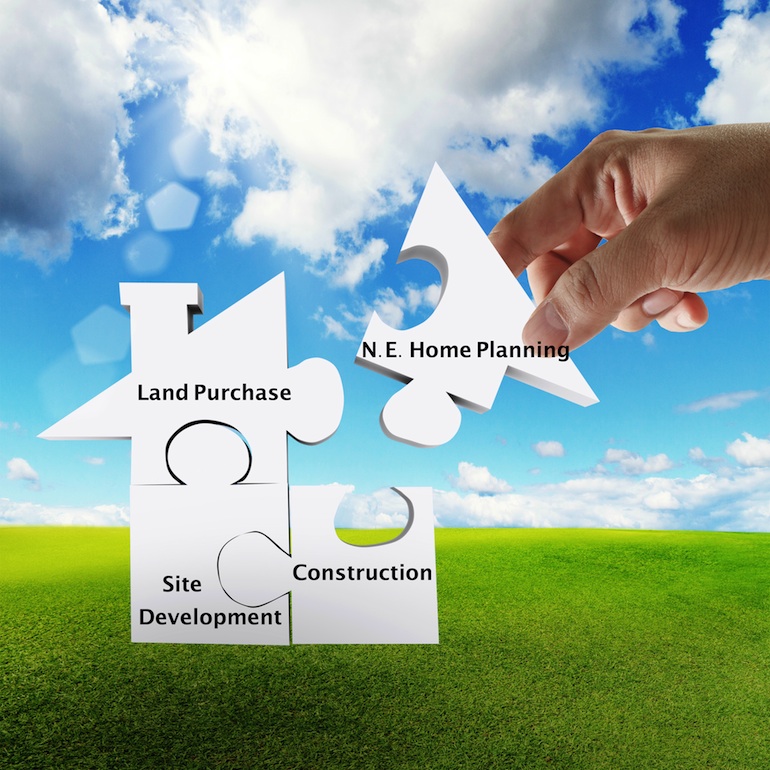
Building Your Modular Dream Home
There are three major parts to the puzzle of building a home:
1. Purchase of land
2. Site Development
3. Construction of Home
Steps to Building Your New Home
- Stop in at our sales center and tell us about your project.
- Locate a lot in the area where you would like to live.
- Gather all information available about the site; plot plan, septic design, covenants etc..
- Choose a few house plan options (or parts of)
- Schedule a site evaluation of your lot.
- Contact your financing partner (or ours) for a pre-qualifying meeting to determine a rough budget estimate.
- Based on the lot information available and desired house plans we will provide you with a rough budget estimate to establish a base line for your project.
- Meet with us to refine your house plans and define the site work to be completed.
- Finalize the building cost and contract totals.
- Purchase and close on the lot with a construction loan and proposed house plans.
- Receive final stamped plans from the factory, supply site plan and get your building permit
- Rough site work, install foundation, well and septic per plan
- Delivery and set of weather -tight modular units by factory crew.
- Install utilities and boiler. Complete Modular Home “button up work.”
- Receive occupancy permit from town.
Pricing Considerations When Building a Home
Once the land has been purchased, or previously owned land has been approved for your project, it is time to move on to the Site Development Phase. Pricing for this phase can vary greatly for each site.
Site Clearing
Tree removal is one of the first steps in preparing the site for building a home.
*The cost for tree clearing with a modular home is the same as with a traditionally built home.
Excavation
Excavation and grading costs can greatly vary depending on the type of land you are building on. Factors such as whether or not the lot os flat, if there are boulders above or below ground, presence of ledge, rock, clay, or hardpan can all greatly affect the cost of excavating your site.
*The cost for excavation with a modular home is the same as with a traditional home
Grading
Grading is a very important part of site preparation. Besides getting your lot to look the way you want, a properly graded lot will also minimize water problems. Occassionally additional grading will be required to allow for delivery of the modular units.
Difference in grading cost for modular is minimal.
Foundation
Foundation costs are usually based on the size of the home. Other factors can include, waterproofing and walk out options.
*The cost of the foundation with a modular home is the same as with a traditional home.
Municipal Water vs. Well Water
Availability of public water will significantly decrease the cost of supplying water to your new home. Costs vary depending on distance of your home site to the public water line. If well drilling is needed, the cost can vary depending on depth of the water table and the type of land that will be drilled.
*Water Supply costs are the same for modular and traditionally built homes.
Sewer or Septic
Sewer drainage costs will also vary depending on distance from the sewer line. Private Septic Costs can range considerably due to local regulations, the type of ground that needs to be excavated and whether a septic field is necessary.
No difference in Sewer or Septic cots with modular and traditionally built homes.
Utility Hookups
Electricity lines are typically installed underground today, which has many benefits down the road but can also have serious costs when planning your home. Built in gas lines increase the value of a home. Even if you do not want to use gas at all, this should factor in your decision to bring in a gas line.
No Difference Between Modular and Traditional Construction for Utility Hookups
Driveway
The length and width of a driveway will typically determine the cost of your driveway, along with the material to be used.Options like heating coils and additional aesthetic curves can add quite a bit of cost to your project.
*No Difference Between Modular and Traditional Construction for Driveway Paving
Walkways & Masonry
Walkways, retaining walls, chimneys, and stairs to your homes’ entrances can vary greatly in cost due to length and materials to be used.
*No Difference Between Modular and Traditional Construction for Walkways or Masonry
Landscaping
Often forgotten when budgeting for building a home, landscaping includes planting and nurturing new grass, buying and installing bushes, shrubs and trees.
*No Difference Between Modular and Traditional Construction for Landscaping
Decks & Porches
Some porches can be built in the factory as part of your home design, but typically decks and porches are not included in the design of your home. These would be designed according to the land your home is built on and the cost would be the same as with traditional building.
*No Difference Between Modular and Traditional Construction for Decks or Porches
